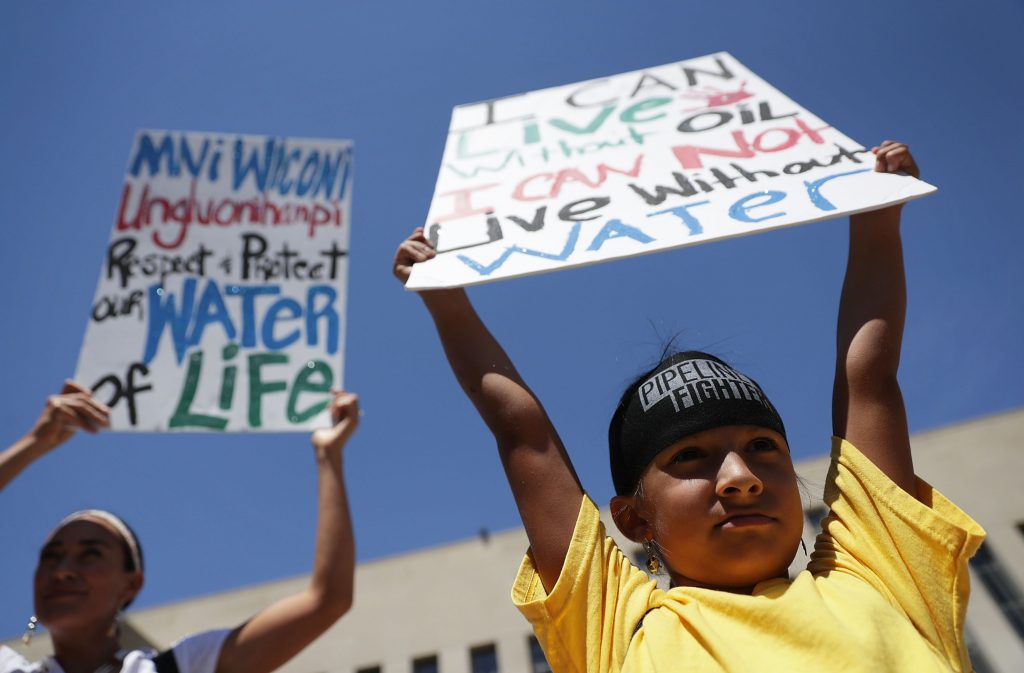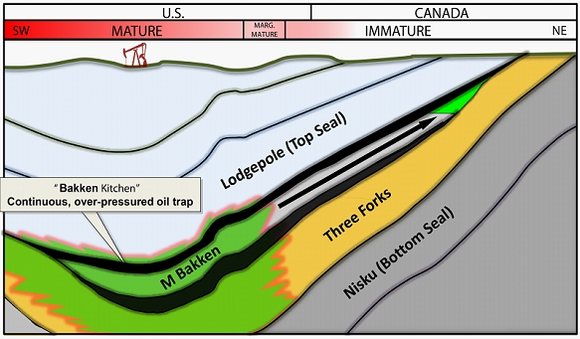(THIS ARTICLE IS MACHINE TRANSLATED by Google from Norwegian)
The system and strategy used to exterminate the Great Plains Indians is just as cruel as gruesome: First, millions of buffaloes were slaughtered so that the indigenous people could no longer be self-sufficient in food and clothing. Then they took the land they lived in, by force. Now, at Statoil, Norway is helping to deprive the Indians of the absolute last valuable thing they have on the land stains they are left with: clean groundwater and drinking water. In 2011, Statoil bought the US oil company Brigham Exploration for 24,5 billion Norwegian kroner. According to Statoil, the company has a strong position in the attractive oil deposits Bakken and Three Forks in the Williston area of North Dakota and Montana. Statoil's strategy is to position itself as a leading player in the US fast-growing industry for land-based oil and gas extraction, said then-Statoil CEO Helge Lund at the time.

In this area, the last survivors of the Lakota Native American tribe live. All indications are that the indigenous people are facing a hopeless fight against the oil industry. In the next 20-30 years, recovery will increase dramatically, with hundreds of new oil wells in former Native American territory. What is happening now is a recent major assault against the surviving Native Americans, who join a host of infamous historic breaches of indigenous peoples. . The police used pepper spray. The oil to be pumped through the pipeline just comes from the Bakken / Three Forks field. The oil field is part of the huge Williston basin, which spans four states – North and South Dakota, Minnesota, and Saskatchewan, Canada. Williston Basin is one of the largest oil fields in the United States, and is estimated to contain over 130 billion barrels of oil. Investors from all over the world  flowing to the Bakken field. Extraction method fracking is highly controversial. In short, the method involves injecting liquid under pressure through a borehole, in order to cause the gas-rich shale layers to crack, so that the shale gas is released and can be collected. The environmental consequences of fracking are many: groundwater pollution, methane gas emissions into the atmosphere, air pollution, pollution through toxic chemicals, drilling mud waste, extreme water consumption during extraction production in water-poor areas and earthquake risk.
flowing to the Bakken field. Extraction method fracking is highly controversial. In short, the method involves injecting liquid under pressure through a borehole, in order to cause the gas-rich shale layers to crack, so that the shale gas is released and can be collected. The environmental consequences of fracking are many: groundwater pollution, methane gas emissions into the atmosphere, air pollution, pollution through toxic chemicals, drilling mud waste, extreme water consumption during extraction production in water-poor areas and earthquake risk.
All indications are that the indigenous people are facing a hopeless fight against the oil industry.
 Indian myth. What is the world really doing? Apache combat helicopters, Tomahawk missiles, Cherokeejeeper? Everyone remembers the Tomahawk rockets that crashed in Baghdad in 2003. Apache helicopters mowing down "terrorists" with mega machine guns. Words and concepts borrowed from the Native American language. The Indians were labeled as the first terrorists in the Promised Land of America. We Europeans needed the enemy image – the wild, crazy, uncivilized native who cried and screamed and dressed like a scarecrow. We had to spin an eternal myth around these strangers who stood in our way and lived in the land we wanted. It was de who scalped, mutilated, tortured, cut women and children, beheaded and burned. Have you heard it before? Indian racism is a separate, well-established Western culture. It has been cultivated for hundreds of years through targeted propaganda. Through literature, stories, illustrations, pictures, films and shows. We've been brought up with cowboy kitsch and Hollywood clichés, which hang like a bloody roller blind in front of our eyes. Buffalo Bill. Silver Arrow. Sad Gufas. If you have empathy with Indians, you are soon seen as hopelessly naive, stupid and romantic backstabbing. Ugh, ugh – dance around the totem pole and swing the tomahawk with feathers in your hair, like.
Indian myth. What is the world really doing? Apache combat helicopters, Tomahawk missiles, Cherokeejeeper? Everyone remembers the Tomahawk rockets that crashed in Baghdad in 2003. Apache helicopters mowing down "terrorists" with mega machine guns. Words and concepts borrowed from the Native American language. The Indians were labeled as the first terrorists in the Promised Land of America. We Europeans needed the enemy image – the wild, crazy, uncivilized native who cried and screamed and dressed like a scarecrow. We had to spin an eternal myth around these strangers who stood in our way and lived in the land we wanted. It was de who scalped, mutilated, tortured, cut women and children, beheaded and burned. Have you heard it before? Indian racism is a separate, well-established Western culture. It has been cultivated for hundreds of years through targeted propaganda. Through literature, stories, illustrations, pictures, films and shows. We've been brought up with cowboy kitsch and Hollywood clichés, which hang like a bloody roller blind in front of our eyes. Buffalo Bill. Silver Arrow. Sad Gufas. If you have empathy with Indians, you are soon seen as hopelessly naive, stupid and romantic backstabbing. Ugh, ugh – dance around the totem pole and swing the tomahawk with feathers in your hair, like.
The imagination of the films has shaped our square perception of the Indians. The delusion has been our true image of the indigenous people. Indians are "lazy and stupid", they steal horses, rob children and are grimacingly angry. We have seen this in countless western films. We still see it. The "wild" have been clowns in the entertainment industry. We flip them down, and we love the revolver heroes – though Danser med ulver with Kevin Costner making an honest attempt to rectify some of this.
Stolen metaphors. «Indian, Indian what did you do for?», Sings Jim Morrison. The prejudices, clichés and racism are inextricably linked to cowboy and Native American play from our earliest childhood. Apache helicopters are tough, Cherokee jeeps are cool. Tomahawk rockets are handsome to "take out" terrorists in Iraq. It is a quirky language game that captivates ethnic values. This is how stolen metaphors are transformed into propaganda purposes. We totally neglect the existence of the Indians, but borrow merrily from their vocabulary for our "peaceful" purposes. They are invisible now, a minority in the big country. Impoverished. They have few rights, "we" manage their lands, draft laws, provide us with their natural resources (and by "we" I mean our European ancestors who founded the United States and their descendants). Why are they so afraid of a regular oil pipeline? They must then be satisfied that they are still alive, that they are not completely wiped out, that was what was the plan. (A quick history lesson: The termination policy was implemented by the United States government in the years 1953-58. The Indians lost their special status and a total of 9700 square miles of land were expropriated.)
This is the reality the Indians are still living to this day. They tie to death. They are excluded from society, removed from the media. It would be against our centuries-old greed to give them back the Black Hills, which were stolen from the Lakota people in 1851. According to the magazine Der Stern, Indigenous people were offered a $ 106 million offer by the United States state for the Black Hills. They refused. Even the United States has extracted gold for $ 15 billion from the Holy Mountains. In Mount Rushmore, George Washington himself is set in stone with Presidents Lincoln, Jefferson and Roosevelt. Sacred area for the Lakota people – best known as the tourist attraction for the United States and the globe.
The Indians were labeled as the first terrorists in the Promised Land of America. We Europeans needed the enemy image – the wild, crazy, uncivilized native who cried and screamed and dressed like a scarecrow.
Fighting against climate change. Today they call themselves water protectors. The Indians are now foremost fighting climate change. The US authorities are giggling about it. In the Morton County Jail, arrested protesters are dressed naked and intimately body-worn, wearing hooded hoods and wearing orange overalls. Little has changed since 1851. The weapons point again to the heads of the Lakota people. Indian video drones are shot down by police snipers. The National Guard has been called. Journalists are imprisoned and harassed. They are fined and threatened with 45 years in prison for documenting protests against Tarsand's Pipeline and Dakota Access Pipeline. Environmental activists are fighting against a ruthless, global oil industry complex. Wild West! This is Trump country.
Environmental fight in practice. The Indians have lost the case in court. Energy Transfer Partners and the Army Corps of Engineers are continuing construction of the pipeline, and they expect to complete it in early November. All historic agreements with the Indians have been systematically broken by US authorities. Therefore, the Indians now occupy the lands that were stolen from them in 1851. The Indian tribes have blocked the road and are taking back expropriated land on the prairie north of the Standing Rock Reservation. They set up tents, pray to the gods and dance to the drums – against the pipeline they call black snake.
(See also the previous Ny Tid article «Indianses last match. ")


